We use affiliate links to run our site. When you buy through links on our site, we may earn an affiliate commission, without any added cost to you. Learn more
Ever thought about having your own stash of homegrown onions? Imagine stepping into your garden and picking fresh, tasty onions for your meals.
In today’s world, where many folks want to know where their food comes from and enjoy healthy eating, growing your onions at home is a smart idea. It means you get to eat onions you’ve grown yourself, without any chemicals.
In this blog post, we’re going to show you the easy way to grow onions in your own backyard. We’ll give you all the tips and steps you need to follow.
Our goal is to help you become an expert in growing onions at home. We’ll guide you through all the steps, and you’ll see that it’s fun and rewarding to grow your onions. By the end of this article, you’ll be all set to grow your onions, and they’ll taste better than the ones you buy.
So, Are you ready to learn how to grow delicious onions in your own space? Start reading to discover the simple yet enriching journey of cultivating your onions at home; even if you are just starting, we’ve got your back.
How to Grow Onions At Home
Different Types of onions:
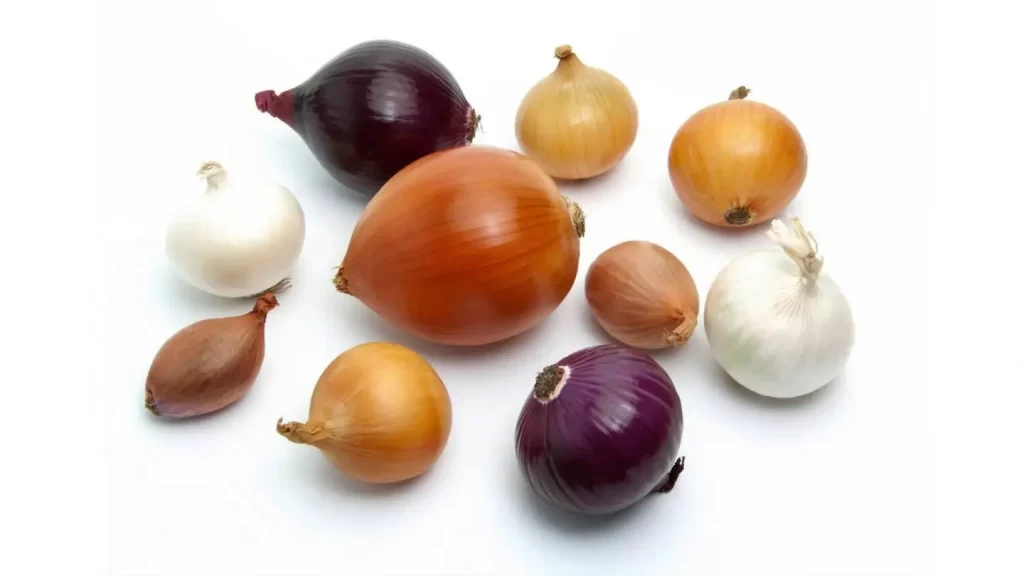
There are numerous ways to differentiate onions like color, shape, size, etc. But we will discuss the main three types of onions based on their maturing period. These are:
- Short-day onions
- Long-day onions, and
- Intermediate-day onions.
Short-day onions are onions that require 10-12 hours of daylight to form bulbs. They are best grown in the Southern States (a latitude of 25-35) where the day length is closer to 12 hours. Short-day onions can be grown in other parts of the country, but they will not bulb as well.
Long-day onions require a longer growing season. They would need at least 14-16 hours of light every day. these onion varieties are perfect for you if you live in the northern states (a latitude from 37-47). They are also very good for long-term storage.
Intermediate-day onions take 12-14 hours of daylight to mature. They perform best in Zones 5 and 6. Ideally, the maturity is reached in 110 days from transplanting.
Choosing the right onion variety
To determine which onion type is right for you, consider your climate and the length of your growing season. If you live in a warmer climate, short-day onions will do well.
If you live in a cooler climate, long-day or intermediate-day onions may be a better option.
Different Methods of Growing onion plants
You can grow onions from
- Seeds,
- Smaller bulbs or onion sets
- or transplant.
growing onions from seed:
If you are planning to start with the seeds, it is better to first grow the seedlings indoors. Use special seedling trays (or can alternatively opt for used Egg cartons) and good quality potting soil.
If you are planning to buy transplants from the market, talk to your nearest garden center or nursery shop. Though in transplant, the choice of variety is limited, the survival chances are pretty high.
Growing from Onion sets:
You can also use immature bulbs also known as onion sets. The best part of choosing bulbs is that they are easy to plant, less disease-prone, and the earliest to harvest.
Choose bulbs that are smaller in size (diameter less than ½ inches). The big-sized bulbs are much more prone to bolting.
Planting Onions:
If you want to have a successful onion crop, the first thing you need to do is to plant them correctly. Follow these steps and you will be rewarded with a bountiful harvest.
Where to plant onions?
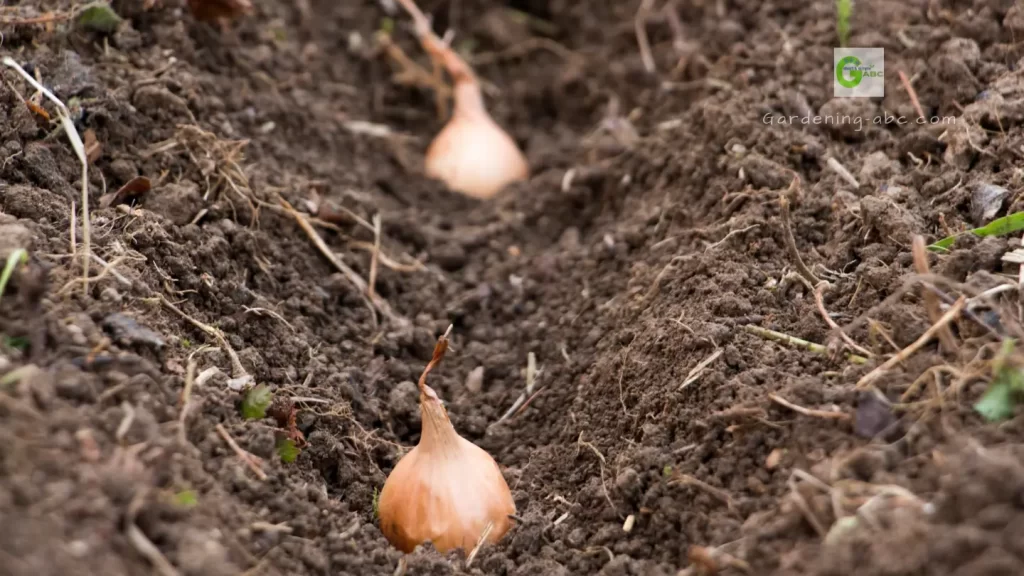
Onions like sunny spots in the garden, so choosing the right location is important. They grow best in light soil that is amended with organic matter.
Raised beds are a good option for onions. It provides warm soil and ideal air circulation to the plant. You can also amend the soil quite easily.
Plant the onions at the depth specified on the seed packet, and space them according to the variety you are growing.
Preparing the best soil for onions:
To have a successful onion crop, you must first prepare the soil. This starts with testing the soil pH and making sure it is in the ideal range for onions. A soil test kit like this is the easiest way to test the pH of your soil.
Start with well-drained, loose soil. Onions do not like soggy conditions, so make sure the area you choose to plant onions has good drainage.
Onions prefer slightly acidic soil, the ideal pH range should be between 6 and 7. Once you know your soil pH, you can make any necessary adjustments to ensure that your onions will have the best chance of thriving.
If your soil is too acidic, you can use these to raise the pH. on the other hand, if it is too alkaline, you can amend the soil like this.
Loosen the soil to a depth of 12 inches with the help of a shovel or tiller. This will allow the onion roots to spread out and access more nutrients.
Next, add a good amount of organic matter to the soil. This can be done by adding compost or manure. This will help improve drainage and aeration while also providing essential nutrients for the plants.
Whatever you do, make sure the soil has very good drainage. Good soil drainage is compulsory for a good yield.
How to plant onions:
Planting onions is not difficult, but there are a few things to keep in mind. First, onion plants should be planted 1″ deep. If you plant deeper, the onions may not bulb.
Second, make sure to space the plants about 4-6 inches apart. This will give the plants room to grow and mature. In case you are planning to harvest green onions (scallions), you can leave a smaller space (2”).
Can You Plant a Sprouted Onion?

Yes, you can plant sprouted onions, in fact, many people prefer to do so because it results in an earlier harvest.
When you get an onion from the store, chances are that the onion has been pre-sprouted. This means that the onion has been started in a controlled environment and then transferred to a grocery store.
If you want to plant an onion that you’ve sprouted yourself, you can surely do so.
To plant a sprouted onion, first, peel off the skin of the onion. Then, separate each individual sprout and plant them in soil that is rich in nutrients.
How to Water onions:
Onions have a shallow root system. This means, that the roots can not get water from the depth of the soil and so take it mostly from the surface and a little beneath. This means while watering, you need to make sure the base of the plant doesn’t become dry.
Overwatering can also be a problem. One of the signs that your plant is getting more water than needed is a tinge of yellow on the leaves. If you find that happening with your plant, reduce the amount of water.
Use Mulch:
Onions cannot compete with most of the weeds. So make sure your soil has minimal or no weeds. You can check organic weed control to know more about how can you remove weeds from your garden.
Using a thick layer of Mulch can be a good idea. You will want to cover them with 2-4 inches of mulch. Mulch will also help keep the soil moist and protect the plant from frosting. There are several types of mulch that you can use, including grass clippings, sawdust, and straw.
Will onions grow through mulch?
The mulch is not the compact portion of the soil it is just the covering of various ingredients on top of the growing soil. the land in many types of soils, for example, with compost, decayed leaves, barks, etc. So ideally they are loose
Mulching is quite common for plants that contain a bulb. When you mulch around the onions it keeps other wild plants and weeds. Onions grow through the bulb and actually prefer mulching.
How To Fertilize Onions Right:
Onions are a cool weather crop and do best when fertilized in the early spring before planting and again in midsummer. A balanced fertilizer such as 10-10-10 is best to feed onions, but avoid using high nitrogen fertilizers which can produce lush foliage at the expense of bulbs.
Nitrogen is necessary for good top growth, but it is the phosphorus and potassium that are essential for good bulb development. Side dress plants with a half cup of fertilizer around each plant about four weeks after planting and again four to six weeks later.
If you are using a granular fertilizer, scatter it evenly on the soil surface and then gently rake it in.
when to harvest onions:
Growing onions is all about getting the bulbs. Once you see the top of the plant turns brown or yellow, your onions are ready to harvest.
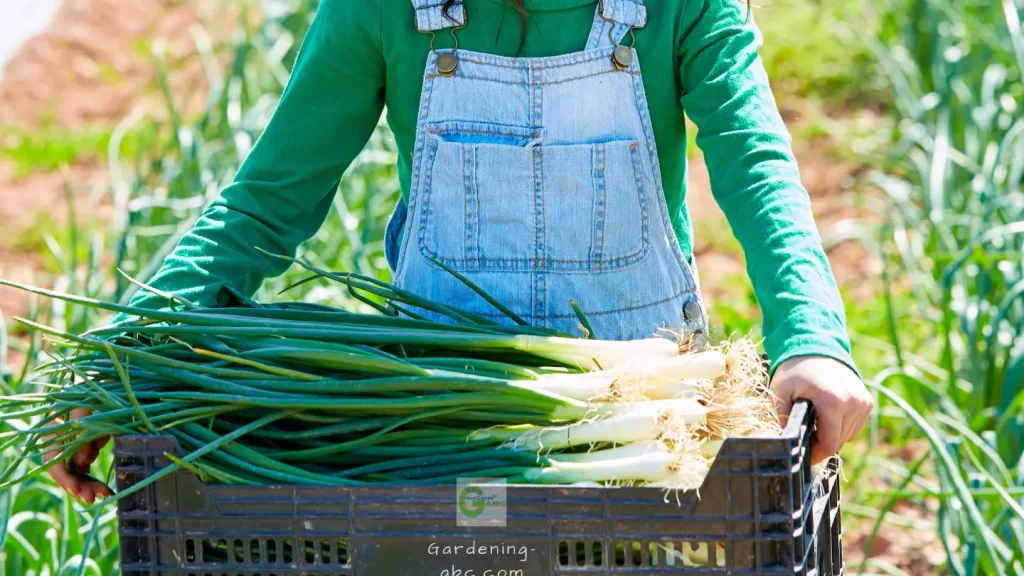
Pull or dig the onions out. After that, leave them in the open sun for two days to dry. This will help prevent rotting.
How to harvest onion seeds:
You can harvest onion seeds and use them in the future. Once the onion tops start to turn brown it’s time to harvest the seeds. Simply clip the flowering head off the stalk a few inches below the head and place it in a paper bag.
The heads will eventually turn brown and the seeds will fall out of the bag when they are ready. you can also shake the paper bag vigorously to fasten the process of seed extraction.
How To Store Onions:
After drying, the skin of the onion will have a uniform texture. Now it is time to trim the roots and detach the stem from the bulb. Remove any soil that is present on the skin.
These onions are now ready to consume and you can eat your onions right away. You can store your onions in plastic bags and keep them in a dry and well-ventilated space.
We have discussed how to store various vegetables in our earlier article. You can check that article if you want to know about the basics of vegetable storage.
What can you grow after onions?
When it comes to planting after onions, the sky’s the limit. If you’re looking to grow tomatoes, chili peppers, winter squash, swedes, winter cabbage, pumpkins, radishes, or lettuce, there’s a spot in your garden waiting for them.
Onions are biennial plants that complete their life cycle in two years. This means that after they’ve flowered and produced seeds in their first year, the plant will die.
This doesn’t mean you can’t plant anything else in the garden bed where onions were grown; it just means you need to be careful not to plant any other biennials in that bed.
Onion Pests and Diseases
Common pests:
Onions are generally hardy plants, but they can still fall victim to a few common pests. So, it’s essential to know how to identify these pests, understand their effects on your onion plants, and, most importantly, how to prevent and manage them.
Here’s a table summarizing the common onion pests, their identification, their impact on your plants, and prevention methods:
| Pest Name | Identification | Effects on Onion Plants | Prevention Methods |
|---|---|---|---|
| Onion Thrips | Tiny, slender insects with fringed wings. Often found on the underside of leaves. Leaves may have tiny black fecal spots. | Leaves turn pale, silvery, or bronze, and curl. Reduced growth, and distorted foliage. Weakened bulbs. | 1. Use row covers. 2. Keep the garden area clean. 3. Introduce predatory insects like ladybugs. |
| Onion Maggots | Small, yellowish-white maggots. Leave behind small holes in bulbs. | Wilting and yellowing of seedlings. Stunted growth and reduced bulb size. | 1. Rotate crops. 2. Use onion sets instead of seeds. 3. Apply beneficial nematodes. |
| Aphids | Tiny, soft-bodied insects, usually green or pink. Cluster on the underside of leaves and stems. Excrete honeydew, leading to sooty mold growth. | Curling, yellowing, and distortion of leaves. Reduced photosynthesis, stunted growth. Transmit viruses. | 1. Spray plants with a strong stream of water. 2. Release ladybugs or lacewings. 3. Neem oil or insecticidal soap applications. |
| White Rot | Fungal disease with white, fluffy mycelium. Affects bulbs in storage, causing rot and decay. Foul odor as bulbs rot. | Yellowing and wilting of leaves. White, cotton-like growth at the base of the plant. Infected bulbs become mushy. | 1. Plant, resistant onion varieties. 2. Practice good crop rotation. 3. Properly space plants for good air circulation. 4. Avoid overhead watering. |
| Bollworms | Green or brown caterpillars with longitudinal stripes. Feed on onion leaves and may bore into bulbs. | Holes in leaves and bulbs. Reduced bulb size and weight. | 1. Inspect plants regularly for caterpillars. 2. Apply Bacillus thuringiensis (Bt) if infestation is severe. 3. Practice crop rotation. |
| Leaf Miners | Tiny, larval insects that create serpentine tunnels on onion leaves. | Scarring and winding trails on leaves. Reduced photosynthesis and growth. | 1. Remove and destroy affected leaves. 2. Maintain good garden hygiene. 3. Use reflective mulch to deter leaf miners. |
Common Diseases of an Onion plant:
Onion plants are susceptible to a variety of diseases, Here are some insights into common diseases that can affect onion plants, along with their causes, effects, and remedies:
| Disease Name | Causing Agent | Effects on Onion Plants | Remedies |
|---|---|---|---|
| Downy Mildew | Peronospora destructor | Purple-gray lesions on leaves, yellowing. Reduced growth and yield. Spores on leaves during humid conditions. | 1. Plant, resistant onion varieties. 2. Proper spacing for good air circulation. 3. Avoid overhead watering. |
| Botrytis Leaf Blight | Botrytis spp. | Wilting, yellowing, and rotting of the basal plate. Stunted growth and reduced bulb size. Foul odor as bulbs rot. | 1. Remove and destroy infected plant material. 2. Proper garden hygiene and cleanup. 3. Good air circulation and avoid crowding. |
| Fusarium Basal Rot | Fusarium oxysporum f. sp. cepae | Wilting, yellowing, and rotting of basal plate. Stunted growth and reduced bulb size. Foul odor as bulbs rot. | 1. Practice crop rotation. 2. Plant disease-free onion sets. 3. Avoid planting in poorly drained soil. |
| Onion Smut | Urocystis cepulae | Dark, raised pustules on leaves and bulbs. Reduced bulb size and yield. Can cause long-term soil contamination. | 1. Remove and destroy infected plants. 2. Use disease-free onion sets or seeds. 3. Proper spacing and avoid overcrowding. |
| Pink Root | Setophoma terrestris | Pink to red discoloration of onion roots. Reduced nutrient uptake and growth. Stunted plants with weakened bulbs. | 1. Practice crop rotation. 2. Plant disease-resistant onion varieties. 3. Proper soil drainage and pH maintenance. |
| Purple Blotch | Alternaria porri | Circular purple spots with white centers on leaves. Reduced bulb size and yield. May cause leaf dieback and defoliation. | 1. Remove and destroy infected plant material. 2. Good garden hygiene and debris removal. 3. Fungicidal sprays in severe cases. |
How to grow onions in a pot:
Onions are a great vegetable to grow in a pot. They don’t need a lot of space and they are relatively easy to grow.
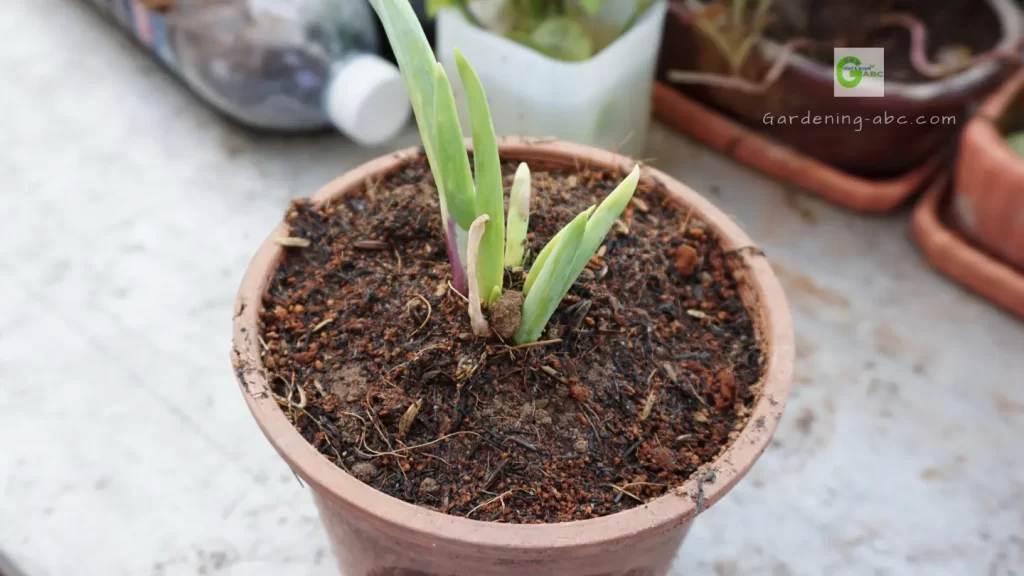
In order to grow onions in a pot, you will need a large-mouthed container so you can harvest them easily.
To get a decent yield you should plant several onions in that pot.
Make sure the pot is at least 10 inches deep otherwise, they won’t get enough space to grow. You can also use tubs to grow onions.
Make sure the container has drainage holes in the bottom so the water can escape. Fill the pot with soil and plant the onions according to the package directions.
Add 2-3 inches of water each week and make sure the soil is moist but not wet. The onions will be ready to harvest when they are big enough for your liking.
Useful tips for growing onions at home:
Onions are a staple in many kitchens, and they can be grown in your garden very easily. Here are 7 tips to get you started:
- Choose the right variety. There are many different types of onions, so choose one that is best suited for your climate and growing conditions.
- Plant onion sets in well-drained soil. Onions need soil that drains well so they don’t rot.
- Add organic matter to the soil before planting. This will help improve drainage and fertility.
- Plant onion sets in early spring, or plant onion seeds directly in the garden in late spring or early summer.
- Space onion plants 12-18 inches apart, depending on the variety.
- Keep weeds under control to avoid competition for nutrients and moisture.
- Mulch around the plants to help retain moisture and suppress weeds.
Conclusion:
In conclusion, growing onions at home is not just about cultivating a delicious addition to your meals; it’s a journey of understanding the various types of onions, choosing the right variety based on your climate, and mastering the art of planting, tending, and harvesting. It’s a rewarding endeavor that puts flavorful, chemical-free onions on your table.
Just as we began this journey with the vision of picking fresh onions from our own garden, we’ve now walked through the steps to make that vision a reality. From selecting the right onion variety to mastering the art of planting, it’s been an enriching journey.
Now, it’s your turn to embark on this green adventure. Consider the climate of your region and the length of your growing season. What type of onions will you choose for your garden? Are you starting from seeds, smaller bulbs, or transplants? Reflect on your garden’s sunny spots, soil quality, and drainage, as these are key factors in your onion’s success.
But this isn’t the end; it’s only the beginning of your onion-growing journey. In our upcoming articles, we’ll dive deeper into specific techniques for planting and caring for your onions. We’ll explore tips for dealing with common onion pests and diseases, ensuring your crop thrives.
As you step away from this article and into your garden, remember that each onion you grow is a testament to your dedication and love for gardening. Start with the knowledge you’ve gained here, and don’t hesitate to seek more information as you nurture your onion crop.
Thank you for joining us on this journey of how to grow onions at home. The satisfaction of plucking your own onions from the garden is a unique joy. We’re excited to share more gardening wisdom with you in the future. Happy gardening, and may your homegrown onions be the highlight of your culinary creations!
Amazon and the Amazon logo are trademarks of Amazon.com, Inc, or its affiliates.
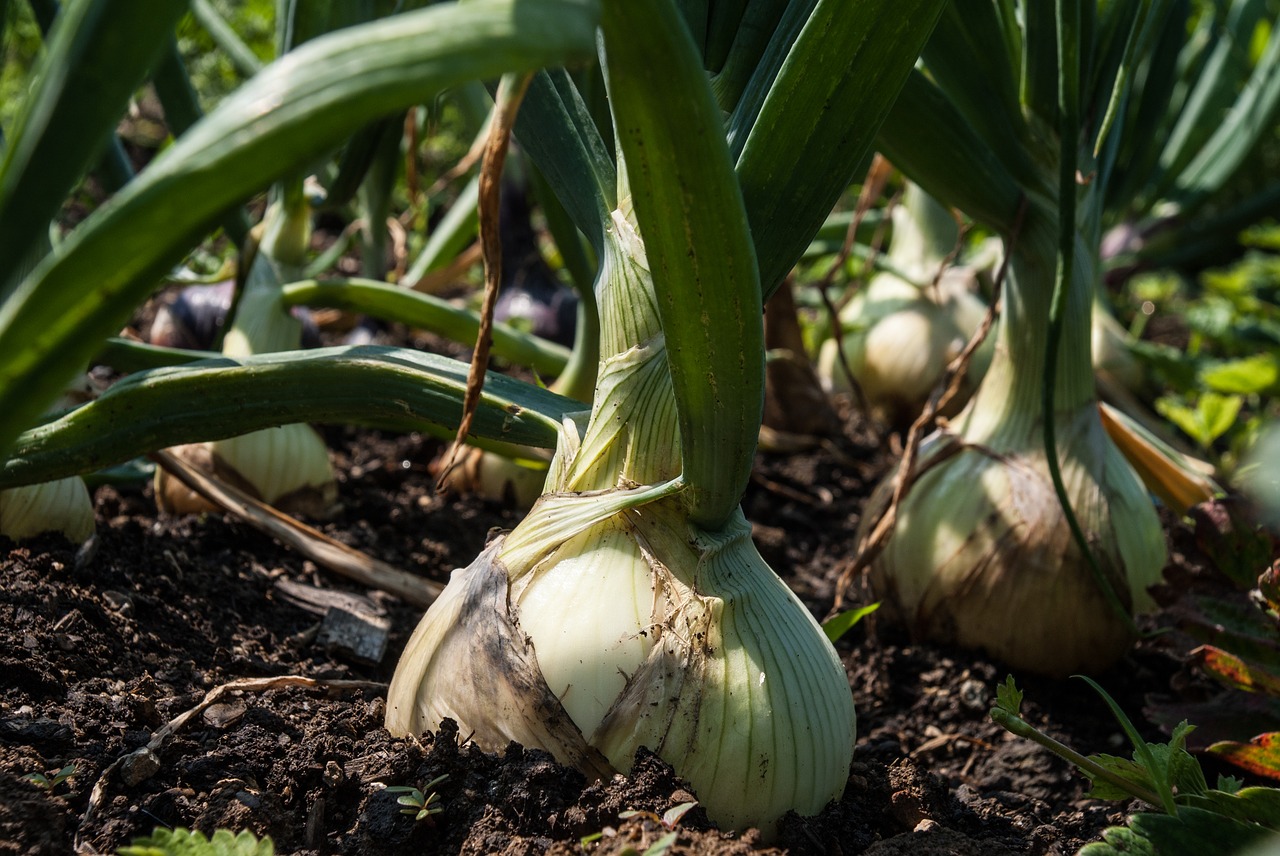
Thanks for the great tips on growing onions! I tried growing them last year, but didn't have much success. I'll have to keep this info in mind this year- I have some onion seeds that I wanted to try to plant.
Thanks for onion tips. I grew some from onion sets last summer and they were lovely – much nicer than shop ones.
I have never grown them from seeds though – maybe I will try. I planted onions sets in raised beds recently to over winter and get early onions this spring but the rain has been so bad I fear they will be waterlogged.